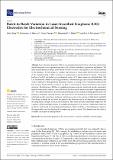| dc.contributor.author | Tang, Yifan | |
| dc.contributor.author | Moreira, Geisianny A. | |
| dc.contributor.author | Vanegas, Diana | |
| dc.contributor.author | Datta, Shoumen P. A. | |
| dc.contributor.author | McLamore, Eric S. | |
| dc.date.accessioned | 2024-07-26T18:10:23Z | |
| dc.date.available | 2024-07-26T18:10:23Z | |
| dc.date.issued | 2024-06-30 | |
| dc.identifier.issn | 2072-666X | |
| dc.identifier.uri | https://hdl.handle.net/1721.1/155794 | |
| dc.description.abstract | Laser-inscribed graphene (LIG) is an emerging material for micro-electronic applications and is being used to develop supercapacitors, soft actuators, triboelectric generators, and sensors. The fabrication technique is simple, yet the batch-to-batch variation of LIG quality is not well documented in the literature. In this study, we conduct experiments to characterize batch-to-batch variation in the manufacturing of LIG electrodes for applications in electrochemical sensing. Numerous batches of 36 LIG electrodes were synthesized using a CO2 laser system on polyimide film. The LIG material was characterized using goniometry, stereomicroscopy, open circuit potentiometry, and cyclic voltammetry. Hydrophobicity and electrochemical screening (cyclic voltammetry) indicate that LIG electrode batch-to-batch variation is less than 5% when using a commercial reference and counter electrode. Metallization of LIG led to a significant increase in peak current and specific capacitance (area between anodic/cathodic curve). However, batch-to-batch variation increased to approximately 30%. Two different platinum electrodeposition techniques were studied, including galvanostatic and frequency-modulated electrodeposition. The study shows that formation of metallized LIG electrodes with high specific capacitance and peak current may come at the expense of high batch variability. This design tradeoff has not been discussed in the literature and is an important consideration if scaling sensor designs for mass use is desired. This study provides important insight into the variation of LIG material properties for scalable development of LIG sensors. Additional studies are needed to understand the underlying mechanism(s) of this variability so that strategies to improve the repeatability may be developed for improving quality control. The dataset from this study is available via an open access repository. | en_US |
| dc.publisher | MDPI AG | en_US |
| dc.relation.isversionof | 10.3390/mi15070874 | en_US |
| dc.rights | Creative Commons Attribution | en_US |
| dc.rights.uri | https://creativecommons.org/licenses/by/4.0/ | en_US |
| dc.source | Multidisciplinary Digital Publishing Institute | en_US |
| dc.title | Batch-to-Batch Variation in Laser-Inscribed Graphene (LIG) Electrodes for Electrochemical Sensing | en_US |
| dc.type | Article | en_US |
| dc.identifier.citation | Tang, Y.; Moreira, G.A.; Vanegas, D.; Datta, S.P.A.; McLamore, E.S. Batch-to-Batch Variation in Laser-Inscribed Graphene (LIG) Electrodes for Electrochemical Sensing. Micromachines 2024, 15, 874. | en_US |
| dc.contributor.department | Massachusetts Institute of Technology. Department of Mechanical Engineering | |
| dc.contributor.department | Massachusetts Institute of Technology. Auto-ID Laboratory | |
| dc.relation.journal | Micromachines | en_US |
| dc.identifier.mitlicense | PUBLISHER_CC | |
| dc.eprint.version | Final published version | en_US |
| dc.type.uri | http://purl.org/eprint/type/JournalArticle | en_US |
| eprint.status | http://purl.org/eprint/status/PeerReviewed | en_US |
| dc.date.updated | 2024-07-26T12:29:09Z | |
| dspace.date.submission | 2024-07-26T12:29:09Z | |
| mit.journal.volume | 15 | en_US |
| mit.journal.issue | 7 | en_US |
| mit.license | PUBLISHER_CC | |
| mit.metadata.status | Authority Work and Publication Information Needed | en_US |
